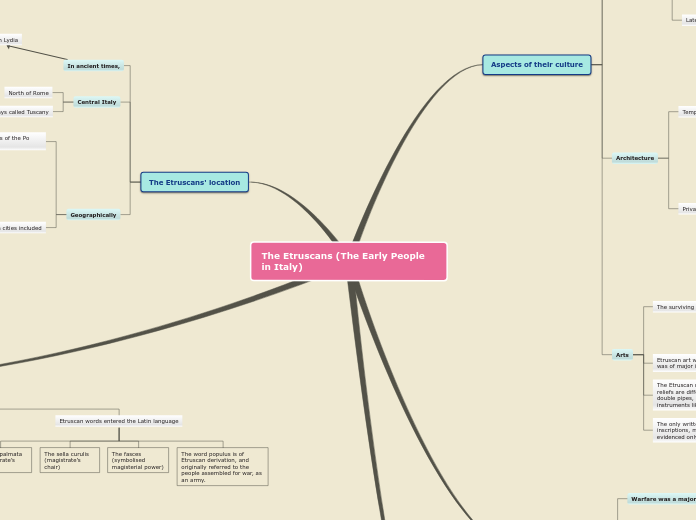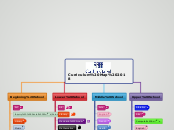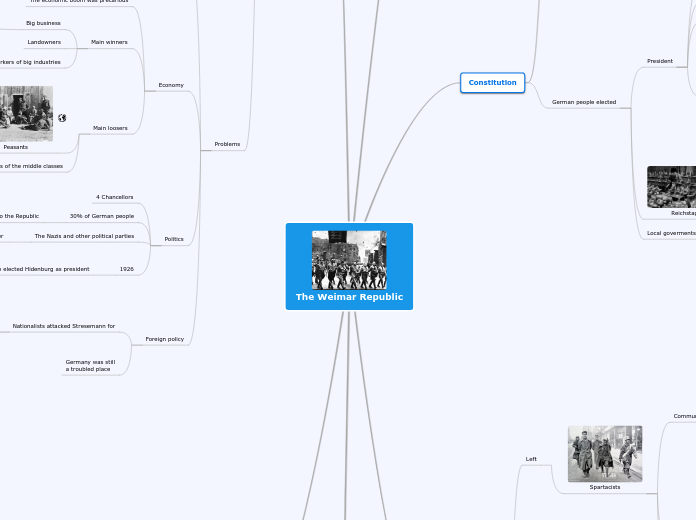The Etruscans (The Early People in Italy)
Etruscan inventions
Certain institutions and customs came directly from the Etruscans to Rome
The Etrsucan elite provided it with
urban infrastructure (walls, forum, drainage system)
its early political arrangements (monarchy, army)
As are the names of its legendary founders
Remus
Romulus
The name of Rome itself has of Etruscan origin
The Etruscans' location
Geographically
The major Etruscan cities included
Vulci
Vetulonia
Veii
Tarquinia
Chiusi
Populonia
Cerveteri
Spread from the Tiber River in the south to parts of the Po Valley in the north
Central Italy
Nowadays called Tuscany
North of Rome
In ancient times,
They migrated from Lydia
Government
The different city-states of Etruria
united by a loose political confederacy.
Different states from going to war with one another from time to time
united by a common religion
The Etruscans adopted the city-state as their political unit from the Greeks
The Etruscan homeland was originally divided into twelve city-states
New cities sprang up as the Etruscans expanded their sphere of influence
Most Etruscan cities moved from monarchy to oligarchy
Some seem to have retained their monarchies
Military Tactics
Prisoners of war could end up on the altars of Etruscan gods and sacrificed.
Grew into the gladiatorial entertainments of the Roman amphitheatres
Prisoners were sometimes set to fight one another
Conducted campaigns during summer months
Engaging in – or combating – piracy
Attempting to gain territory
Raiding neighbouring areas
Warfare was a major aspect of their political life
Aspects of their culture
Arts
The only written records of Etruscan origin that remain are inscriptions, mainly funerary. Otherwise, Etruscan literature is evidenced only in references by later Roman authors.
The Etruscan musical instruments seen in frescoes and bas-reliefs are different types of pipes, such as Pan pipes and double pipes, percussion instruments, and stringed instruments like the lyre
Etruscan art was strongly connected to religion; the afterlife was of major importance in Etruscan art
The surviving Etruscan art
Metalworking
Wall-painting
Cast bronze
Figurative sculpture in terracotta
Architecture
Private houses
Opposite was a large room, with a hearth and cistern, and side rooms including accommodation for servants.
Had an atrium, an entrance hall open to the sky in the centre and with a shallow basin on the floor in the middle for collecting rainwater
Multiple intercommunicating rooms, sometimes with a hall and a private courtyard, all on one floor
Temples
Each town had three main temples
Evolved into more solid and imposing structures using stone and Tuscan columns
Started with dried mud-brick buildings using wooden poles and thatch roofs
Where they could make offerings to their gods
Religion
Later, Greek deities were taken into the Etruscan system
Pacha (Dionysus)
Menrva (Minerva)
Aritimi (Artemis)
Polytheistic
Cel, the earth goddess
Uni the wife
Tin or Tinia, the sky
Etruscan Heritage
The early Romans were deeply influenced by their more civilized Etruscan rulers
Helped to shape Roman civilization, the Etruscans had an enduring influence on later Western culture
Can be seen in the Romans’ writing, art and architecture, religion, military matters, entertainment
Etruscan words entered the Latin language
The word populus is of Etruscan derivation, and originally referred to the people assembled for war, as an army.
The fasces (symbolised magisterial power)
The sella curulis (magistrate’s chair)
The toga palmata (a magistrate’s robe)
For Rome
Turned Rome into a full-blown city-state
Urban infrastructure (walls, forum, drainage system)
Provided it with its early political arrangements (monarchy, army)









